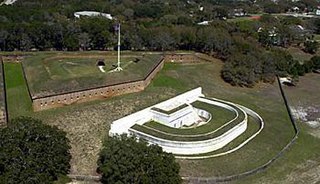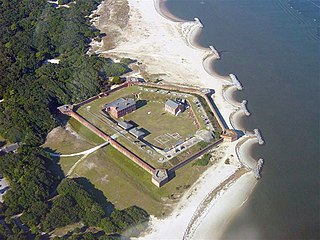 W
WFort Barrancas (1839) or Fort San Carlos de Barrancas is a United States military fort and National Historic Landmark in the former Warrington area of Pensacola, Florida, located physically within Naval Air Station Pensacola, which was developed later around it.
 W
WFort Brooke was a historical military post situated on the east bank of the Hillsborough River in present-day Tampa, Florida. The fort was established in 1824, soon after Florida was acquired by the United States from Spain. It was an important post during the Seminole Wars and of lesser importance during the United States Civil War. It was decommissioned in 1883, and the land was eventually sold to private interests.
 W
WThe Castillo de San Marcos is the oldest masonry fort in the continental United States; it is located on the western shore of Matanzas Bay in the city of St. Augustine, Florida.
 W
WFort Clinch is a 19th-century masonry coastal fortification, built as part of the Third System of seacoast defense conceived by the United States. It is located on a peninsula near the northernmost point of Amelia Island in Nassau County, Florida. The fort lies to the northeast of Fernandina Beach at the entrance to the Cumberland Sound, in the northeast part of the state. Today it is included within the boundaries of Fort Clinch State Park.
 W
WProspect Bluff Historic Sites is located in Franklin County, Florida, on the Apalachicola River, 6 miles (9.7 km) SW of Sumatra, Florida. The site contains the ruins of two fortsThe earlier and larger one was built by the British in 1814, during the War of 1812. They allowed the members of the disbanded Corps of Colonial Marines, made up largely of fugitive slaves, and Creek tribesmen to occupy it after the British evacuated Florida in 1815, deliberately leaving their munitions behind. At that point, since the British had not named it, Americans started referring to it as Negro Fort. It was destroyed in a river attack from U.S. forces in 1816. Fort Gadsden was built in 1818 within the former walls of the former Negro Fort.
 W
WFort Jefferson is a massive but unfinished coastal fortress. It is the largest brick masonry structure in the Americas, and is composed of over 16 million bricks. The building covers 16 acres (6.5 ha). Among United States forts, only Fort Monroe in Virginia and Fort Adams in Rhode Island are larger. The fort is located on Garden Key in the lower Florida Keys within the Dry Tortugas National Park, 68 miles (109 km) west of the island of Key West. The Dry Tortugas are part of Monroe County, Florida, United States.
 W
WThe Battle of Pensacola was a battle between the Confederate States of America troops occupying Pensacola Bay and the Union fleet under Harvey Brown. The Confederates retained control of the city and its forts after months of siege.
 W
WFort McRee was a historic military fort constructed by the United States on the eastern tip of Perdido Key to defend Pensacola and its important natural harbor. In the defense of Pensacola Bay, Fort McRee was accompanied by Fort Pickens, located across Pensacola Pass on Santa Rosa Island, and Fort Barrancas, located across Pensacola Bay on the grounds of what is now Naval Air Station (NAS) Pensacola. Fort Pickens was the largest of these. Very little remains of Fort McRee today.
 W
WFort Pickens is a pentagonal historic United States military fort on Santa Rosa Island in the Pensacola, Florida, area. It is named after American Revolutionary War hero Andrew Pickens. The fort was completed in 1834 and was one of the few forts in the South that remained in Union hands throughout the American Civil War. It remained in use until 1947. Fort Pickens is included within the Gulf Islands National Seashore, and as such, is administered by the National Park Service.
 W
WFort Ward was a Confederate States of America fort located in Wakulla County, Florida, at the confluence of the Wakulla River and St. Marks River and named after Colonel George T. Ward, owner of Southwood Plantation, Waverly Plantation, and Clifford Place Plantation south of Tallahassee. During the American Civil War, Confederate troops placed a battery of cannons at Fort Ward.
 W
WYellow Bluff Fort Historic State Park is a Florida State Park in Jacksonville, Florida. It is located near the mouth of the St. Johns River, a mile south of State Road 105 on New Berlin Road, in the cities Northside area. On September 29, 1970, it was added to the U.S. National Register of Historic Places.
 W
WThe Fort Zachary Taylor Historic State Park, better known simply as Fort Taylor is a Florida State Park and National Historic Landmark centered on a Civil War-era fort located near the southern tip of Key West, Florida.